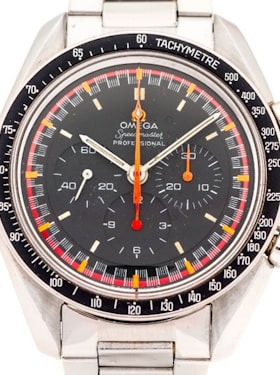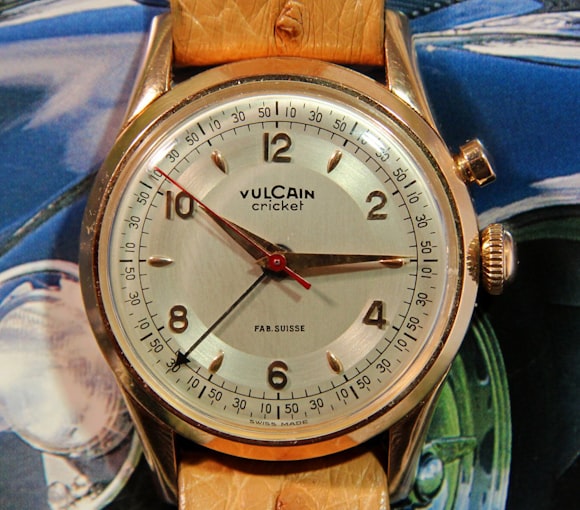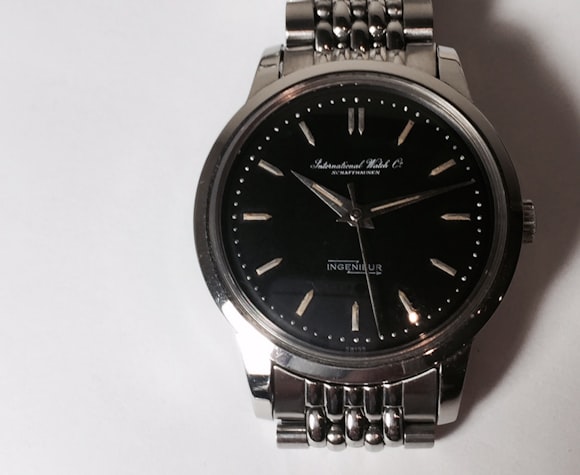This week, Bring A Loupe covers some of the most emblematic wristwatches ever made – watches that have become symbols of the companies that made them. We're starting with a couple of vintage Speedmasters, and you will also see a Futurematic from Jaeger-LeCoultre as well as a Cricket from Vulcain, both technically advanced watches for their time. Finally, Bidder Beware returns with two watches that you should absolutely not buy on eBay today (or ever). This is your Bring A Loupe for January 15, 2016.
An Omega Speedmaster Reference 2915-3, AKA The Transitional

The Reference 2915 was the first Speedmaster ever produced, over a three-year span from 1957 onwards. As it often happens with vintage watches, it is also the most coveted and valuable of the Speedmasters; think for instance of the first GMT from Rolex or the first waterproof chronograph from Patek – both enjoy greater success with collectors than later models. The Speedmaster Reference 2915 actually saw three separate iterations: if you remember Ben's dedicated Reference Points, each display some small differences that makes it either a "Dash One," "Dash Two," or "Dash Three" for the Omega fans. The 2915-3 is interesting in that it may or may not show the two most identifiable characteristics of the reference 2915: a stainless-steel bezel and broad arrows. It is therefore called the Transitional, as it can also be closer in looks to the next Speedmaster model, the reference 2998. That's a lot of numbers; it is easier to simply look at the picture of this Speedmaster 2915-3, indeed featuring a black bezel and alpha hands that would be expected in a later 2998. Note on the black bezel the "DON" (dot over ninety) that you should find in early Speedmasters. Or course, this 2915-3 comes in a 38 mm case, housing the manual-winding caliber 321, as you would expect from a Speedmaster with a pre-Professional dial.
The Italian dealer Andrea Foffi is offering this rare Speedmaster here, with an extract from Omega's archives documenting that this chronograph was initially sold in the U.S.

Two Omega Speedmaster With Exotic Racing Dial, The Original Reference 145.022 And The Re-Edition Reference 3570.40


It is rare to see those two Speedmasters side by side. On the right, the original Speedmaster with the exotic racing dial; this special version of the 145.022 goes for around $30,000 nowadays. And, on the left, a later limited edition reference 3570.40, made in 2,004 examples for Japan back in 2004. You probably guessed the one I would like to own the most – the original, of course. That said, it is fun to play the "spot the difference" game with those two. Obviously, you would notice a different bracelet, a different bezel, different indexes, and much more. So now the choice is yours between a very unusual Speedy from the 1970s or its faithful reproduction more than 30 years later. I am only worried by the following sentence in the description of the original 145.022: "The hands appeared to have been painted in orange to match the dial" – hopefully not a sign that there is something amiss.
Davidoff Brothers listed these two watches – you can find the original here and the re-edition here; the latter is priced at 7,800 CHF (or around $7,700), reflecting the attention that this modern Speedmaster is actually getting.
A Jaeger-LeCoultre Futurematic Reference E502, With Porthole Indicator

This Futurematic Porthole might very well be my favorite vintage watch from Jaeger-LeCoultre. That's quite a big statement, but I have many reasons. First, its functionality is highly innovative: the watch does not feature any visible crown, as it can only be set from a recessed crown on the back. Winding is actually not an option, hence the power-reserve indicator on the left counter and the small arrow on the right indicating the running seconds. The watch was designed to keep at least six hours of power at all times so it could start at the first motion that released energy to its bumper movement. This quirky feature fully underlines the talent of Jaeger-LeCoultre for developing amazing movements – remember that they had none other than Audemars Piguet, Cartier, and Vacheron Constantin as contractors. The aesthetic of this version is quite striking, the best of any Futurematic in my book. Those two round counters explain the "Porthole" nickname of this Futurematic reference E502, and can't be found on any other watch. Lastly, it comes in a 37 mm stainless-steel case, while most of the Futurematic you would find are in yellow gold or gold plated, and solely signed LeCoultre, those being actually smaller at only 35 mm.
A Dutch dealer is offering this glorious Futurematic for sale here.

A Patek Philippe Calatrava Reference 570, With Tiffany Bracelet

Calatrava became a common name to describe a dress watch, as Patek Philippe really nailed down the quintessential design of such a watch when launching the reference 96 in the early 1930s. Ironically, the reference 96 was not even called "Calatrava" at the time; this marketing nod to Patek's emblem came much later. The original reference 96 was only 31 mm in diameter, so you should think of the later reference 570 as its larger carbon copy with a 35.5 mm diameter, which explains its current success. The watch here displays the rarer central second, the long blued hands nicely contrasting with the yellow-gold case. In addition, engravings on the case back and the signed bracelet seem to indicate that it was originally sold by Tiffany & Co, although no attached papers could substantiate that; let's call the Tiffany provenance a very strong – and attractive – possibility.
The Keystone is offering this dashing Calatrava for $28,500 here.
A Vulcain Cricket In Rose Gold

While Vulcain was not the first to create a wristwatch with an alarm complication – Eterna seems to have been the first in the early 1900s – the Cricket model was the first really successful one from the early 1940s, later followed by the legendary Memovox from Jaeger-LeCoultre. The history is interesting but the actual watch we've found is just stunning, with an incredibly well preserved dial and a rare rose-gold case. The in-house Caliber 120 offers two independent barrels for the time and the alarm; you wind the first by turning the crown clockwise and the alarm by turning it counterclockwise. Setting the alarm almost requires an engineering degree but the owner will provide detailed instructions. The "Fab. Suisse" mention on the dial indicates that this watch was originally intended for the French market after WWII, when gold imports were strictly restricted.
A collector is selling his beautiful Cricket – and the original box – for $2,850, you can find the detailed listing here.
An IWC Ingenieur Reference 666A With Black Dial

"Ideal for all professional men who require a watch which is fully reliable, accurate and trouble free under all conditions" – this was the promise of the IWC Ingenieur when it was launched in the 1950s. The Ingenieur offers protection against one of the greatest enemy of watches: magnetic fields. It does so by encasing its automatic movement under a soft iron inner case and dial, which provides amagnetic protection. This watch here belongs to the first generation of Ingenieurs, as evidenced by its devilish reference 666A – A for automatic, while the AD denomination describes the addition of a date function. I especially like that this Ingenieur features a black dial, more rarely seen than the silver one, while the 36.5 mm case remains relevant some 60 years after the launch.
This black dial Ingenieur is offered for $6,900 here.

Bidder Beware – A Very Wrong Bulova Diver

There are so many things wrong with this Bulova that it would be faster to start with the correct parts: the case and bezel. Additionally, the minute and hour hands are okay for this model, but the chronograph second hand has the wrong shape and color. As for the rest, the dial is a tragedy. The sub-registers are horrific: their unit track doesn't match the size of the correct Bulova. It also lacks the mention of tritium and the "666" seems too close to "FEET." Lastly, the crown should be signed, and in a different style.
You can find this mixed-up Bulova on eBay here.
Bidder Beware – A Military Universal Geneve Polerouter Sub Diver

Welcome back to the "Australian" Polerouter Sub with its bogus military markings. You can read all about those fakes on this fantastic thread, and all the signs are there: a second generation dial with a space in "Gene ve" typical of fakes, crude crowns, and the wrong engravings on the case back. As for the military markings, they are widely known to be fanciful, but you have to applaud that the faker went on creating consecutive numbers; the one we discovered last summer had a serial number two digits after the 20463 number here.
This problematic Polerouter Sub is listed on eBay here but I would not recommend bidding.
No comments:
Post a Comment